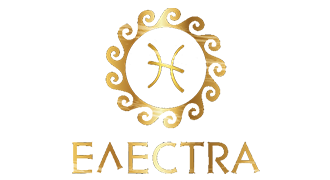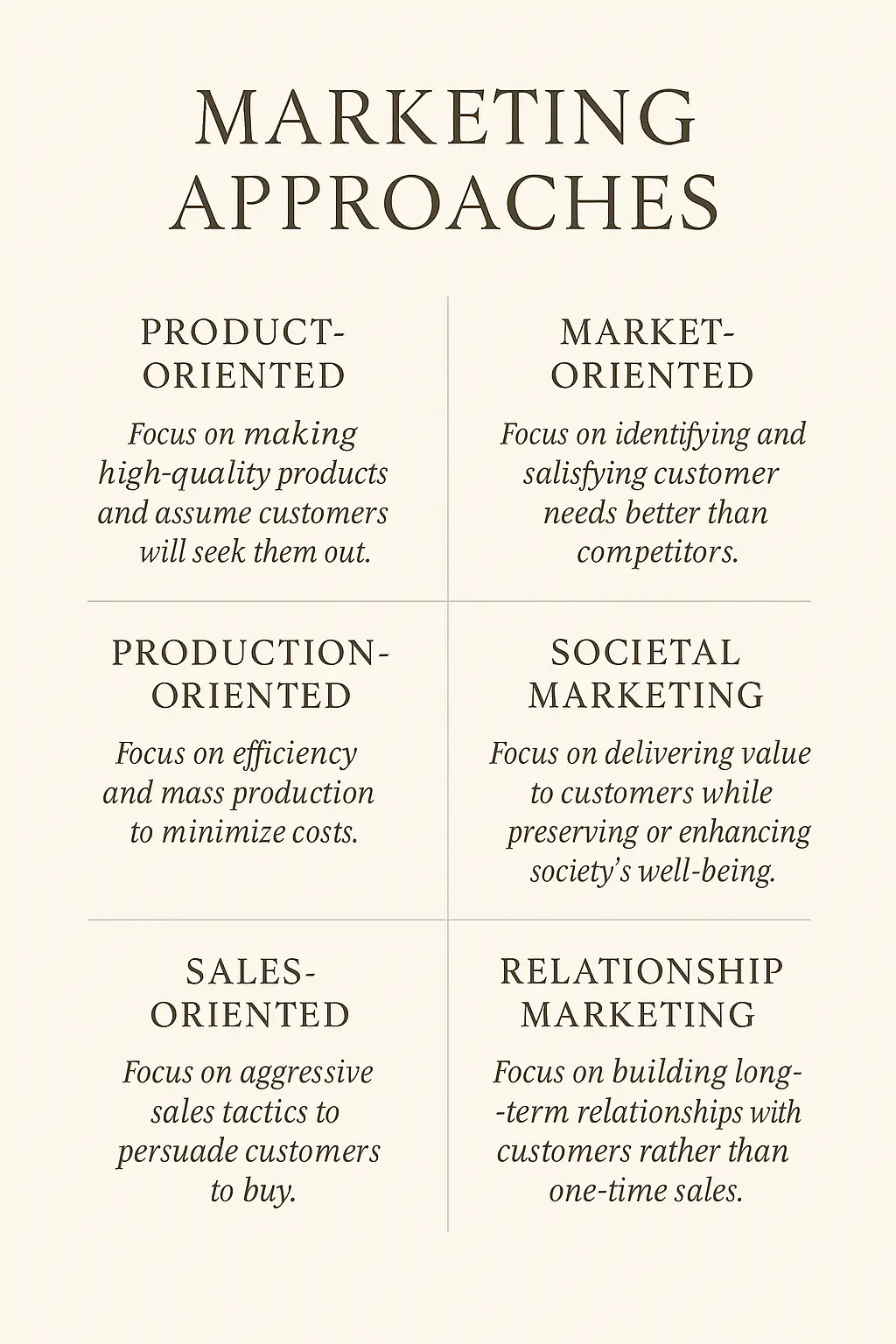Abstract
Marketing approaches are strategic frameworks that guide how businesses identify customer needs, position their offerings, and deliver value. These approaches evolve based on market conditions, technological advancements, and changes in consumer behavior. This article provides a detailed breakdown of the major marketing approaches—traditional and modern—highlighting their core principles, advantages, and applications.
1. Introduction
A marketing approach is the overarching philosophy or mindset that shapes how an organization engages with its market. It dictates how products are developed, communicated, priced, and distributed. Choosing the right approach is critical for aligning business operations with consumer expectations and market realities.
Historically, businesses have transitioned through several dominant marketing orientations. While some companies still use traditional methods, most modern organizations adopt a hybrid of approaches to remain competitive in a dynamic market.
2. Traditional Marketing Approaches
2.1. Product-Oriented Approach
“Focus on making high-quality products and assume customers will seek them out.”
- Core Idea: Emphasis is placed on continuous product improvement and innovation.
- Assumption: A superior product will sell itself.
- Best Suited For: Technology, luxury, and manufacturing industries with low competition.
- Example: Dyson emphasizes engineering and product quality in vacuum cleaners and fans.
✔️ Advantages:
- Promotes innovation.
- Builds strong product reputation.
⚠️ Limitations:
- Can overlook customer preferences.
- Risk of product features customers don’t want.
2.2. Production-Oriented Approach
“Focus on efficiency and mass production to minimize costs.”
- Core Idea: High production volume reduces costs, enabling competitive pricing.
- Assumption: Consumers prioritize affordability and availability over features.
- Best Suited For: Commodities, fast-moving consumer goods (FMCGs).
- Example: Henry Ford’s Model T—“Any color, as long as it’s black.”
✔️ Advantages:
- Economies of scale.
- Price competitiveness.
⚠️ Limitations:
- Ignores differentiation and market segmentation.
- May not meet specific consumer desires.
2.3. Sales-Oriented Approach
“Focus on aggressive sales tactics to persuade customers to buy.”
- Core Idea: Push products through promotion, regardless of customer demand.
- Assumption: With the right persuasion, any product can be sold.
- Best Suited For: Unsought goods (e.g., insurance) and overstocked items.
- Example: Telemarketing, door-to-door sales, or hard-sell car dealerships.
✔️ Advantages:
- Boosts short-term revenue.
- Moves excess inventory.
⚠️ Limitations:
- Often leads to low customer retention.
- Perceived as manipulative or aggressive.
3. Modern Marketing Approaches
3.1. Market-Oriented Approach
“Focus on identifying and satisfying customer needs better than competitors.”
- Core Idea: Understand the market through research and adapt products accordingly.
- Assumption: Long-term success comes from delivering superior customer value.
- Best Suited For: Most modern businesses.
- Example: Netflix analyzes viewer data to tailor content and recommendations.
✔️ Advantages:
- High customer satisfaction and loyalty.
- Encourages innovation aligned with market needs.
⚠️ Limitations:
- Requires constant investment in research.
- Can be reactive rather than visionary.
3.2. Societal Marketing Approach
“Focus on delivering value to customers while preserving or enhancing society’s well-being.”
- Core Idea: Balance profitability with environmental and social responsibilities.
- Assumption: Ethical, sustainable companies gain long-term trust.
- Best Suited For: Eco-conscious and CSR-driven businesses.
- Example: Patagonia’s campaigns on environmental conservation.
✔️ Advantages:
- Builds strong brand image.
- Appeals to ethically conscious consumers.
⚠️ Limitations:
- Higher costs for sustainable practices.
- May conflict with short-term profits.
3.3. Relationship Marketing Approach
“Focus on building long-term relationships with customers rather than one-time sales.”
- Core Idea: Loyalty and trust yield repeat business and referrals.
- Assumption: Retaining customers is more profitable than acquiring new ones.
- Best Suited For: Service industries, SaaS, subscription models.
- Example: Starbucks’ loyalty rewards app that incentivizes repeat purchases.
✔️ Advantages:
- Increases customer lifetime value (CLV).
- Improves retention and brand advocacy.
⚠️ Limitations:
- Takes time to build.
- Can be difficult to scale quickly.
3.4. Digital Marketing Approach
“Focus on engaging customers through digital channels and data analytics.”
- Core Idea: Use online platforms, SEO, content, social media, and analytics to attract and convert customers.
- Assumption: Customers are digitally connected and expect personalized, real-time interactions.
- Best Suited For: E-commerce, media, startups, and modern B2C/B2B businesses.
- Example: Amazon’s personalized recommendations and remarketing campaigns.
✔️ Advantages:
- Measurable results and ROI.
- Global reach and audience segmentation.
⚠️ Limitations:
- Constantly evolving landscape.
- Risk of data privacy issues and ad fatigue.
3.5. Holistic Marketing Approach
“Focus on integrating all marketing efforts to create a unified brand strategy.”
- Core Idea: Every part of the business—internal marketing, relationship marketing, societal marketing, and integrated marketing—must work together.
- Assumption: Marketing is more than a department; it’s a company-wide responsibility.
- Best Suited For: Large, customer-centric organizations.
- Example: Apple combines sleek product design, consistent messaging, ethical values, and customer service.
✔️ Advantages:
- Cohesive brand identity.
- Aligns organizational culture with customer expectations.
⚠️ Limitations:
- Complex to implement.
- Requires strong leadership and communication across departments.
4. Comparative Summary of Marketing Approaches
| Approach | Focus | Best For | Strength | Limitation |
|---|---|---|---|---|
| Product-Oriented | Product quality | Tech/luxury | Innovation | May ignore customer needs |
| Production-Oriented | Efficiency & cost | Commodities/FMCGs | Price competitiveness | Lack of differentiation |
| Sales-Oriented | Persuasion & promotion | Overstocks/unsought goods | Short-term revenue boost | Poor retention |
| Market-Oriented | Customer needs | Most modern firms | Customer loyalty | Cost of research |
| Societal Marketing | Social/environmental impact | Ethical brands | Trust & long-term image | High sustainability cost |
| Relationship Marketing | Long-term customer loyalty | Services/SaaS | CLV & retention | Slow results |
| Digital Marketing | Online engagement & data | E-commerce, startups | Precision targeting | Ad fatigue, privacy concerns |
| Holistic Marketing | Integrated strategy & alignment | Large organizations | Unified brand experience | Complexity |
5. Conclusion
The choice of marketing approach significantly influences a company’s brand image, customer relationships, and market performance. While traditional approaches still hold value in certain contexts, modern marketing requires greater adaptability, customer understanding, ethical commitment, and digital fluency. Many organizations benefit from combining multiple approaches to meet the diverse needs of today’s consumers.
The right approach depends on your product, market, values, and goals—but all successful marketing strategies start with understanding the customer.

